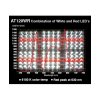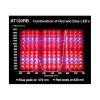brahbrahbinks
Member
I think the best way that we can educate people on which led system actually works is to provide accurate readings that are unbiased and scientific. Par and pur are so far the best way to measure light that is able to be absorbed by plants. Everyone should join me in emailing and calling companies to find out what the actually par readings are.
Par from 12" or 1'
Lumigrow Es 330: 480 micromols
Lumigrow Es 165: 240 micromols
Apache Tech AT-120: 890 micromols
That's all I got for now, if any one wants to chime in be my guest.
Par from 12" or 1'
Lumigrow Es 330: 480 micromols
Lumigrow Es 165: 240 micromols
Apache Tech AT-120: 890 micromols
That's all I got for now, if any one wants to chime in be my guest.



